
ECHINACEA PURPUREA - CULTIVARS VS. SPECIES Musing about new Mt. Cuba trials 2020
Posted by Radovan Hajek, US Perennials on Feb 02 2021
It’s wonderful that Botanic Garden and Research Center Mt. Cuba in Delaware runs their trial gardens. One of many reasons, why this place was voted the Best BotanicGarden in 2020.
Quite recently Mt. Cuba started to observe attractiveness for pollinators on the trialed plants. This is a difficult, maybe debatable task...Do the plants only attract or truly support the pollinators? There is still a lot of unknown, especially about the quality of nectar or pollen and the general reward for pollinators, but lets predict that insects can sense and distinguish all of it. So let's be thankful for such a data, since they may be the only scientific based data that we have for now.
Mt. Cuba is settled in Mid-Atlantic region, but it seems like the data do work for the Midwest conditions too (with some understandable limitations or exceptions). So far, Mt. Cuba counted pollinator’s visits for genus Coreopsis, Helenium, Phlox, Monarda and the most recent cultivars of Echinacea (2018-2020).
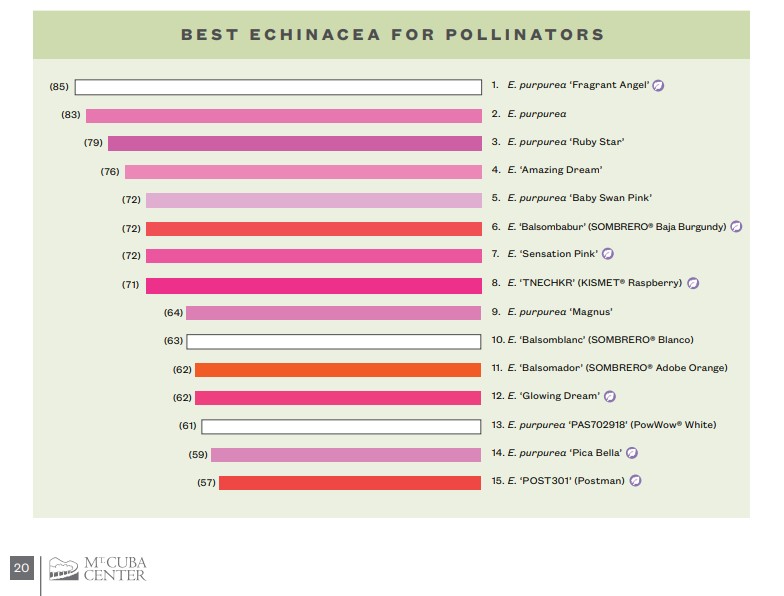
I did small research for myself, just to learn more about the parentshood influence on the top 18 pollinator's favorite Echinacea.
The reason for my musings and thoughts are comments of people, who claim their truth to be the only truth - that the natural, open pollinated plants are the best for the pollinators or insects (“wild species” without any human touch of breeding or selection) .
I also don’t like blaming the cultivars for not being “enough natural”.
If the statements above are true, it would make sense to focus and grow wildflowers only. “The wildflower people” seem to fight “the horticulturalists” and it’s a pity and counterproductive, because both groups can have similar common goals. Data from Mt. Cuba are just data, “neutral” and based on observations and I wish they’ll help to connect both groups in deeper understanding and cooperation.
Why do we have cultivars?
In our gardens, pollinators are “only” one of the desirable traits. What is also important is general performance, uniform look, drought tolerance, better color, amount of flowers on the clump, more compact and non-flopping shape, more horizontal petals, disease resistance or longer blooming season.
Nature can be playful and we, people, are curious and we like to discover new possibilities and push the boundaries a bit further.
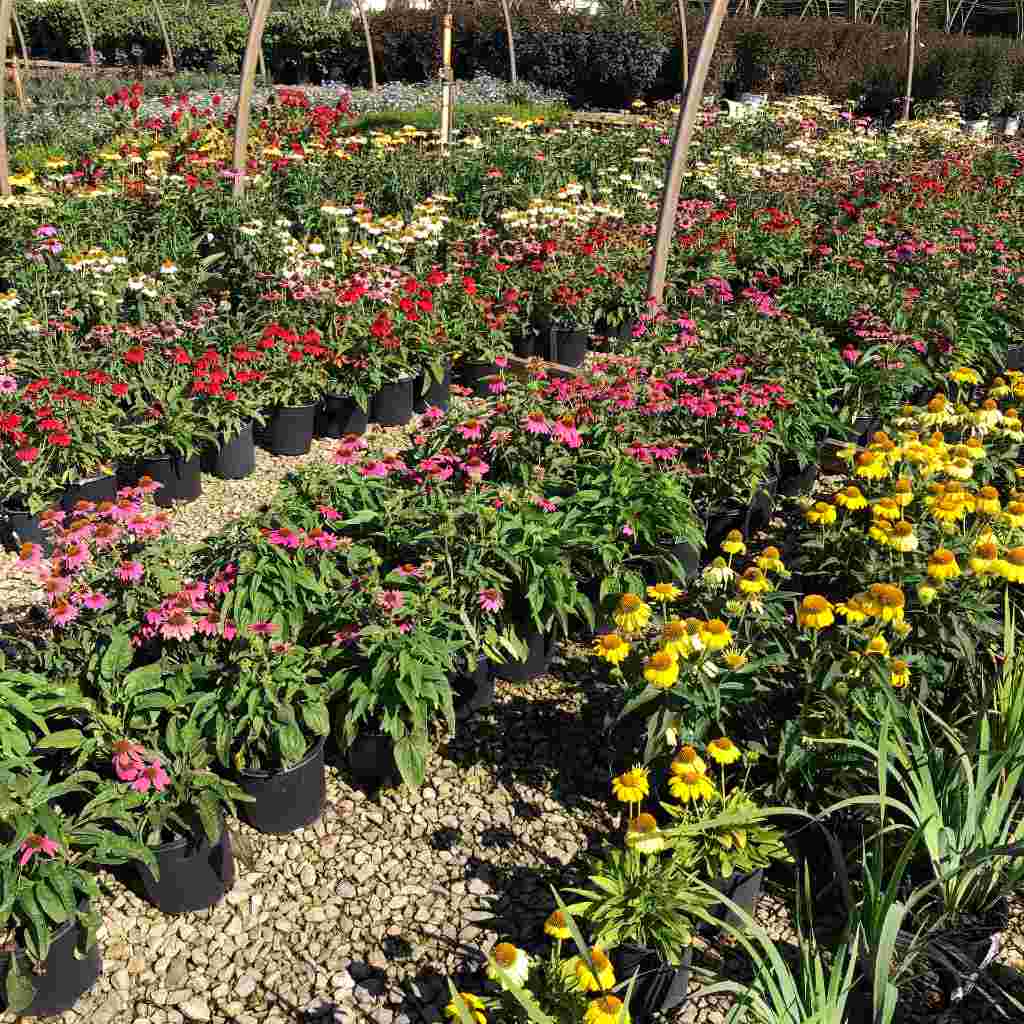
Wholesale nursery, Indianapolis - most of the offered coneflowers are new dwarf cultivars, with dense and compact growth, often with "disproportion" between flowers and the whole habitus. These have only limited use in the front of the flower bed or containers. But American yards are large and need bigger and taller plants and plants that can support pollinators.
Can pollinators feed on wilted plants?
The species of Echinacea purpurea is often quoted as drought tolerant, but I would correct it : it’s moderately drought tolerant. That’s what my colleague Andrew Marrs and myself have observed.
When you see Echinacea purpurea in natural/naturalized areas, at least here in south central Indiana, it often moves to the woodland edge, where it’s happy in partial shade or even in all day long dappled shade, where more moisture is. Even in the sun, species of E. purpurea is supported, shaded and sheltered by other tall prairie plants :
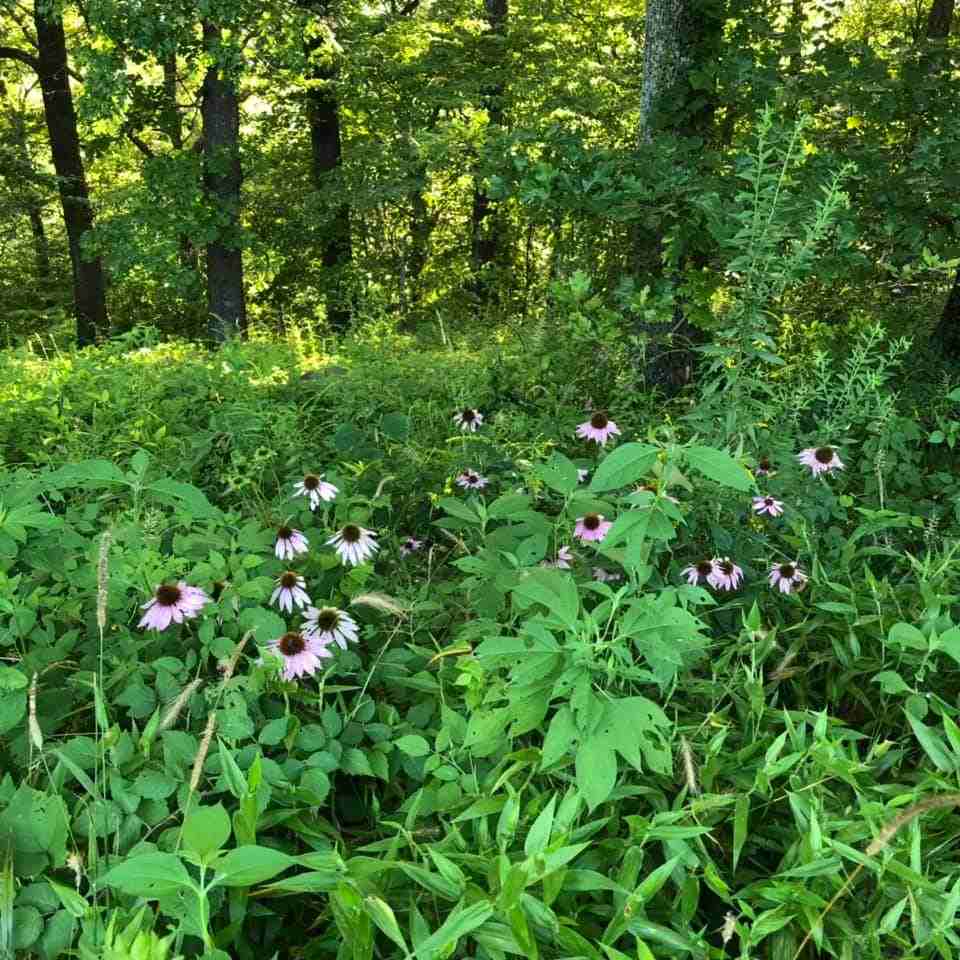
Echinacea purpurea planted on it’s own in flower bed, exposed fully to the sun and heat can wilt quickly, if not supported or shaded by other plants close by. And in summer droughts can turn crispy brown, especially on positions open to south (which happen last summer 2020, that was fairly dry here).
There is common rule for this = the right plant on the right place. But in case of Echinacea purpurea, the drought tolerance is too often “repeated myth”, which can easily lead to failure in many gardens.

Echinacea purpurea - exposed plants, without support and shading of other plants, can wilt quite quickly. Source and picture copyright : https://plant-collage.com/tag/echinacea/
Echinacea purpurea has the largest, fresh green leaves of all the most common and grown species. This tells us, that it does like some moisture (some sources say optimally 1-2 inches of rain per week in the growing season, which is the growth optimum).
Other coneflowers like Echinacea tenneseensis, Echinacea pallida, Echinacea angustifolia or Echinacea paradoxa have narrow leaves, some even hairy leaves to reduce water transpiration. Narrow-leaved coneflowers also have tap root going deeper in the soil, which E. purpurea doesn’t.
Under - Echinacea palllida - charming and underused. Earlier, but also shorter season flowering coneflower. Tough, long-lived and super drought tolerant :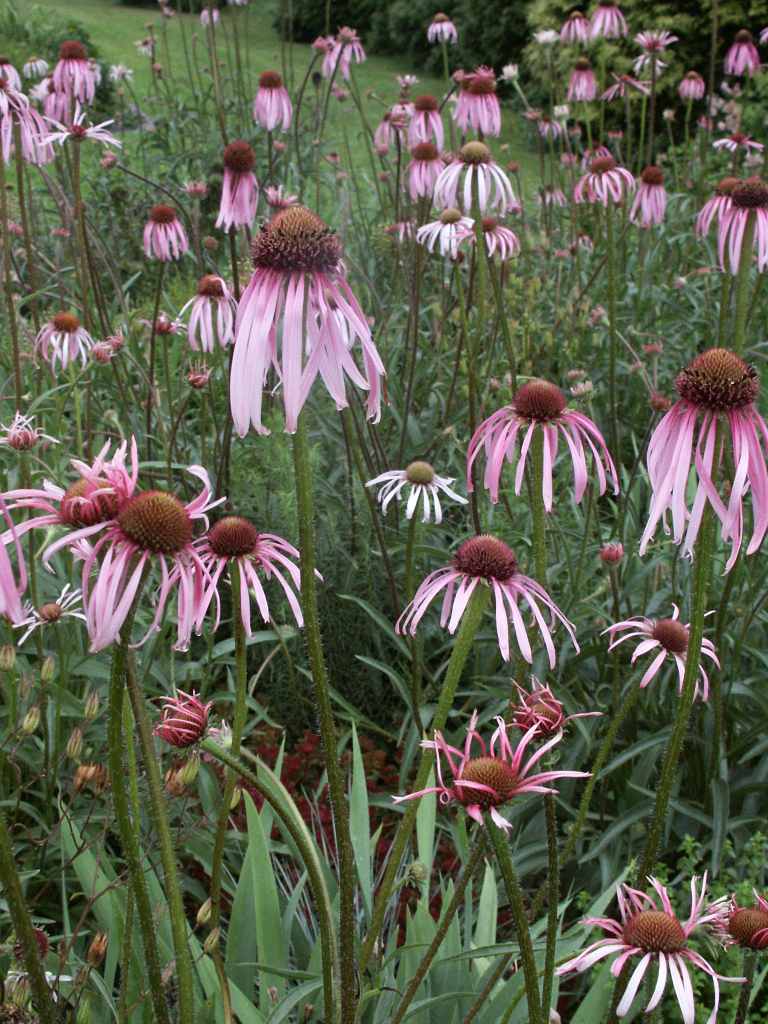
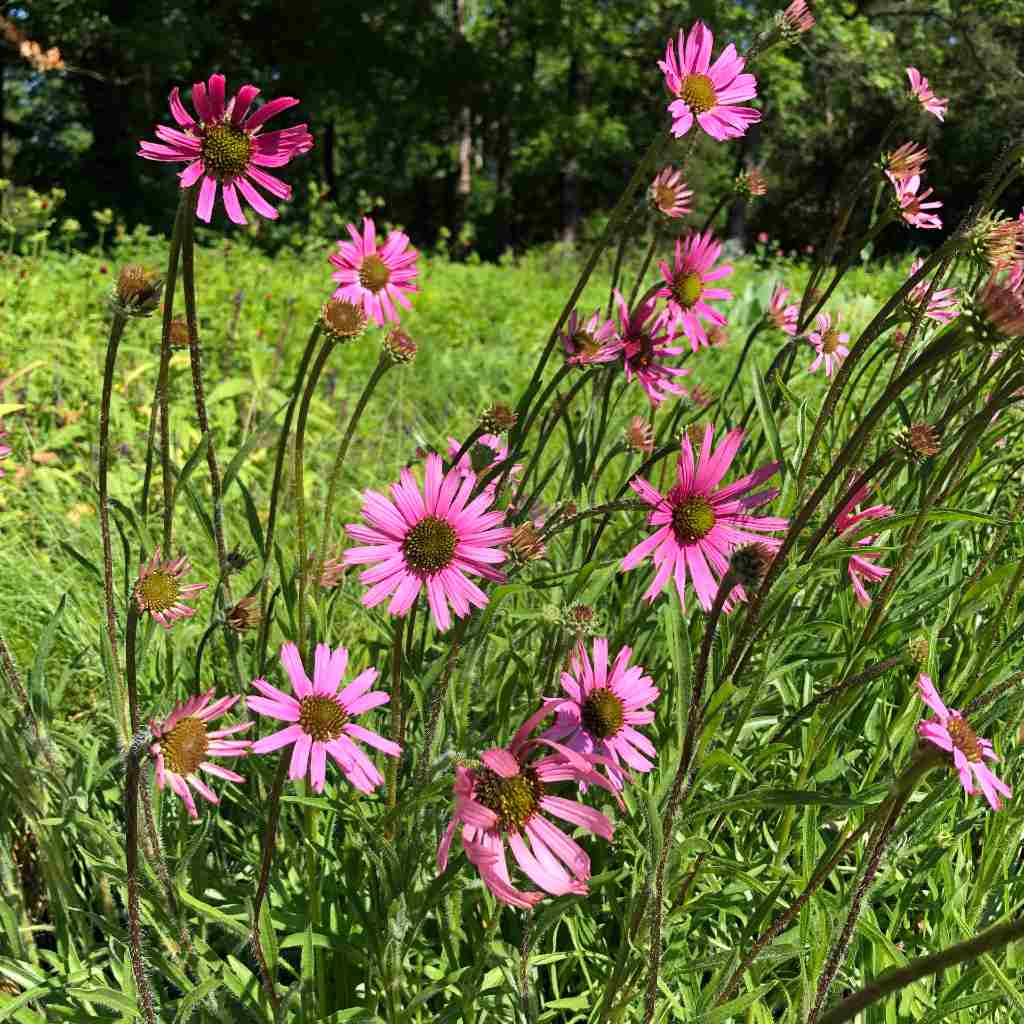
Above - Echinacea tennesseensis - very drought tolerant and flowering for the most of the season - this is the exception of the narrow-leaved coneflowers group. Flowers turn towards sunshine a bit like sunflowers. Very underused coneflower and nearly unknown in horticulture (!), but it placed as 18th most pollinator attractive coneflower.
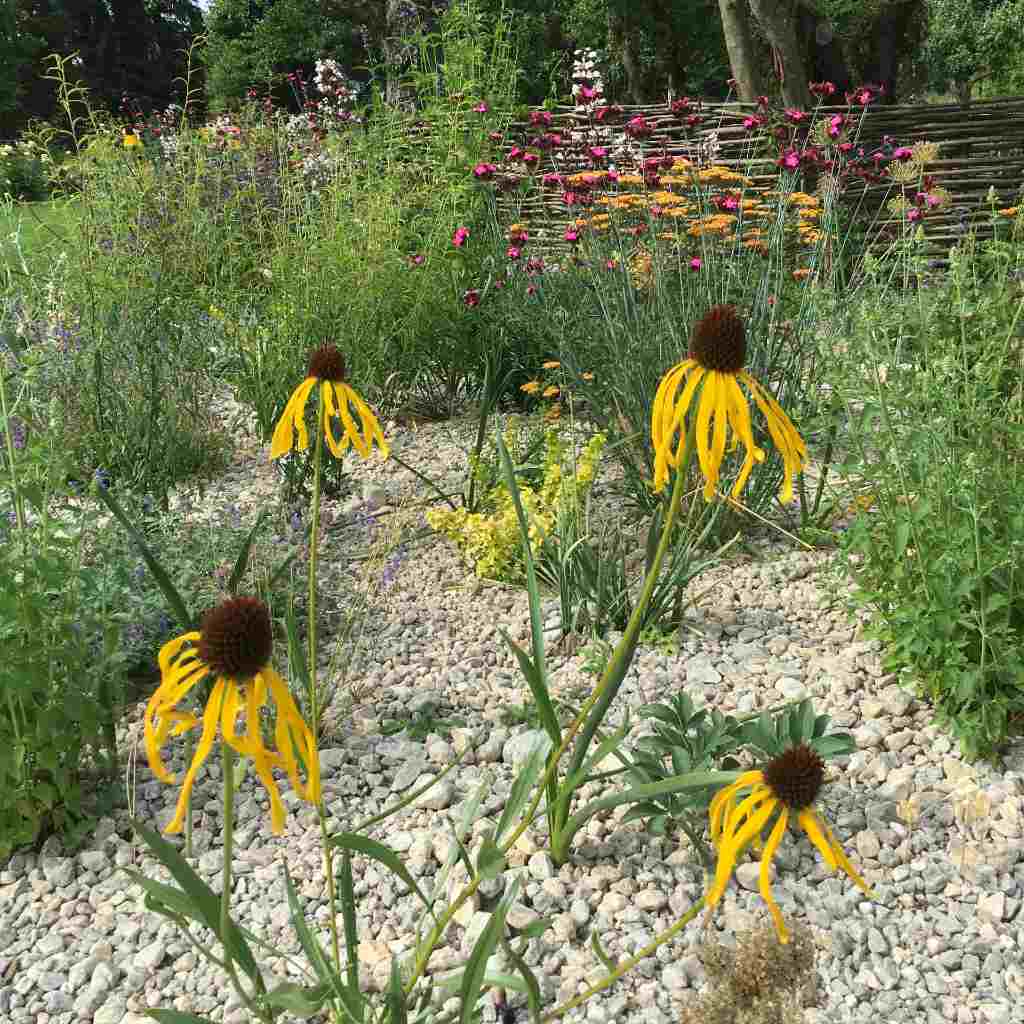
Above - Echinacea paradoxa in newly plated, drought resistant flower bed, mulched with about 4" thick layer of gravel (Czech republic). Majority of narrow-leaved species flower
a bit earlier and for much shorter period of time, so they
can’t feed the pollinators for too long. E. paradoxa is important parent in breeding, because it brought the warm orange color (and potentially it's drought tolerance). Great plant and again underused in landscaping.
......back to summer droughts - wilted plants don’t feed pollinators much.This is the moment when cultivar with the genes of narrow-leaved coneflower can be useful, because it inherited better drought tolerance.
Especially in urban areas, that can be more stressful, hotter, drier and with changed soil profiles, better drought tolerance can be important trait.
18 top pollinator cultivars (vs. 18 top performers) :
I tried to uncover the parentshood of the top performers and compare it with top pollinator favorite coneflower cultivars. Here is the list of best pollinator cultivars.
Green marked plants are the top 12 performers, orange are the second best = honorable performers :
- 1-Echinacea purpurea ‘Fragrant Angel’ (the 9th best performer) - cultivar of Echinacea purpurea, selected as seedling of cultivar ‘Ruby Giant’ (source https://patents.google.com/patent/USPP16054P2/en )
- 2-Echinacea purpurea – species (native wildflower)
- 3-Echinacea purpurea ‘Ruby Star’ – seed propagated cultivar of Ech. purpurea
- 4-Echinacea x hybrid ‘Amazing Dream’ (the 4th best performer) – hybrid of E. purpurea and E. tennesseensis (source https://www.terranovanurseries.com = the breeder)
- 5-Echinacea hybrid ‘Sensation Pink’ (the 2nd best performer)– cross of E. purpurea and E. angustifolia (“The Inventor made a controlled cross in July 2008 in his test garden in Warmond, The Netherlands between an unnamed proprietary seedling of Echinacea purpurea from the Inventors breeding program as the female parent, and an unnamed proprietary seedling of Echinacea angustifolia as the male parent. ‘Sensation Pink’ was selected in August 2011 as a single unique plant amongst the resulting seedlings from the above cross.”, source https://patents.justia.com/patent/PP26593 )
- 6-Echinacea x hybrid ‘Balsombabur’ (‘Sombrero Baja Burgundy’) is cross of female hybrid Echinacea with male hybrid Echinacea (note – hybrids can contain genes of more than one species). Source : https://www.freepatentsonline.com/y2017/0055426.html or https://patents.justia.com/patent/PP28162
- 7-Echinacea purpurea ‘Baby Swan Pink’ – seed propagated cultivar of Ech. Purpurea
- 8-Echinacea x hybrid TNECHKR ‘Kismet Raspberry’ (the 4th best performer) – “The exact parents of this selection are unknown, unnamed, proprietary interspecific hybrids bred from Echinacea paradoxa, Echinacea purpurea, and Echinacea tennesseensis”, source https://patents.justia.com/patent/PP28768
- 9-Echinacea purpurea ‘Magnus’ – seed propagated cultivar of Ech. Purpurea
- 10-Echinacea‘Balsomblanc’ (‘Sombrero Blanco’) – not described parentship, but looks like multiple crosses of F1 and F2 seedlings of Ech. Purpurea cultivars
- 11-Echinacea ‘Glowing Dream’ (the 7th best performer)– “The exact parents of this selection are unknown, unnamed, proprietary interspecific hybrids of Echinacea paradoxa, Echinacea purpurea, and Echinacea tennesseensis. This cultivar was selected for its glowing coral pink flowers.” Source : https://patents.justia.com/patent/PP24329
- 12-Echinacea ‘Sombrero Adobe Orange’ – multiple cross of Echinacea hybrid with other multiple Echinacea hybrid, source : https://patents.justia.com/patent/PP26639
- 13-Echinacea purpurea ‘Pow Wow White’ – seed propagated cultivar of Ech. Purpurea, source https://patents.google.com/patent/US7982110B2/en
- 14-Echinacea purpurea ‘Pica Bella’ (the 1st best performer)- seedling of E. purpurea ‘Abenstem’, source : https://www.missouribotanicalgarden.org/PlantFinder/PlantFinderDetails.aspx?taxonid=267678&isprofile=0&
- 15-Echinacea POST301 ‘Postman’(the 6th best performer) – “selection of Echinacea hybrida identified as code number 651-01, not patented, as the female, or seed, parent with Echinacea hybrida ‘Purple Emperor”, source https://patents.justia.com/patent/PP28524
- 16-Echinacea purpurea ‘White Swan’ – seed propagated cultivar of Ec. Purpurea
- 17-Echinacea tennesseensis – species (wildflower). Note – rumors say that cultivar ‘Rocky Top Hybrids’is still the wild form, that was sold on the market in the times when the species was critically endangered in nature and couldn’t be propagated or sold
- 18-Echinacea hybrid ‘BALSOMSED’ (‘Sombrero Salsa Red’) – cross of selection of Echinacea hybrida with another selection of Echinacea hybrida, source https://patents.justia.com/patent/PP23105
Echinacea purpurea is the key species for pollinators!
Echinacea purpurea, true wildflower placed second, right behind cultivar ‘Fragrant Angel’. Ok, it was tight, but there are other, lot more hybridized cultivars and they are still excellent pollinator plant!
By other words - human influenced (“man-made”) selections can be better, as good, nearly as good for pollinators than the natural forms. So the human input of selection or even mixing several species doesn’t have to be necessarily bad only (but yes, majority of cultivars can be pretty bad too).
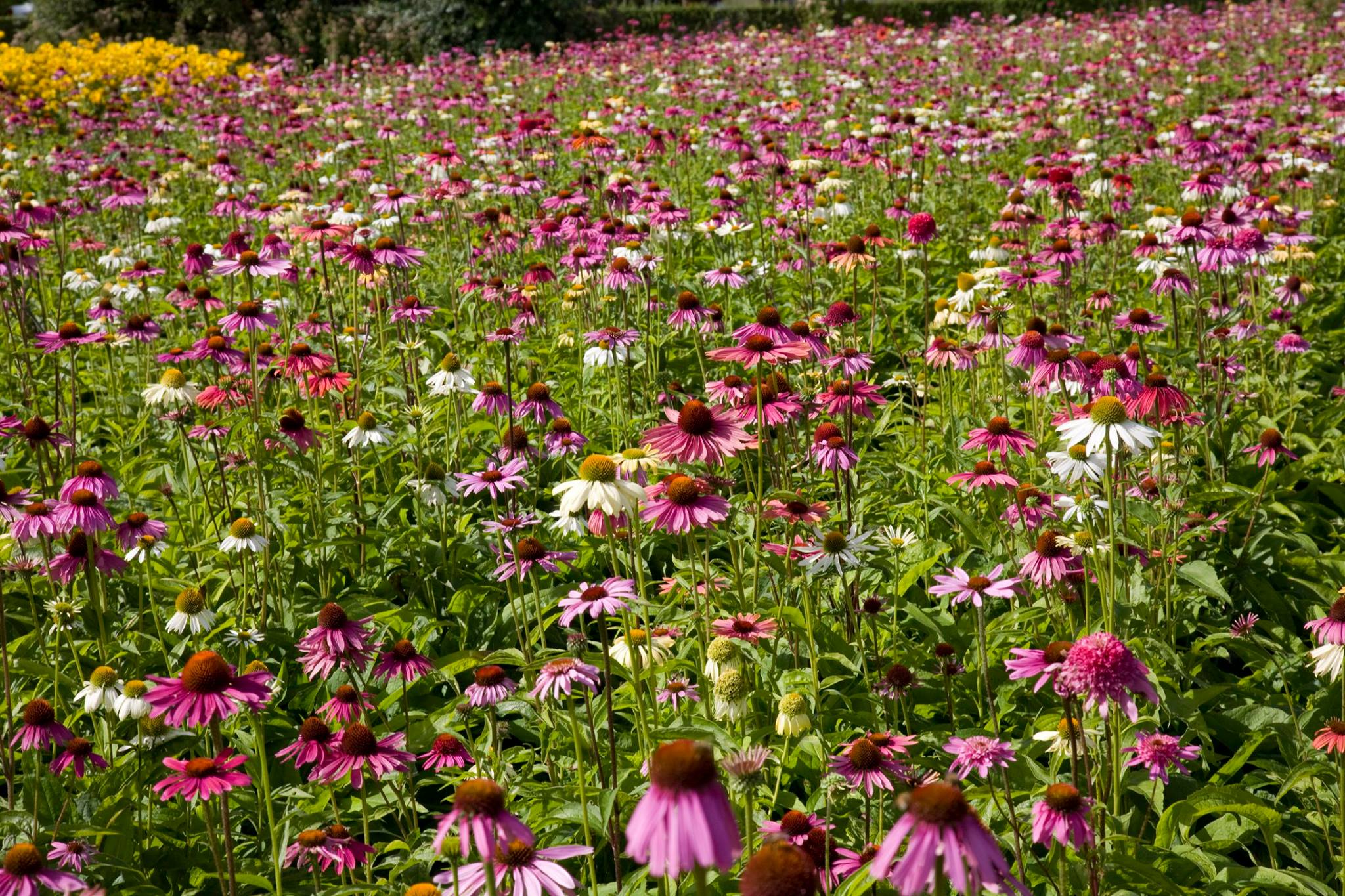
Above - field of Echinacea purpurea seedlings - from here are selected the perspective individuals for further hybridization. (Probably) all coneflower cultivars are seedlings at some
point of their life. The hybridizers just notice their specialty and start to propagate them
vegetatively (by division, cutting or from tissue culture).
Picture copyright : Marco von Noort Breeding, Holland
In the pollinator top chart is quite high presence of the seed propagated cultivars, so it is obvious that Echinacea purpurea is the key species for pollinators!
(also when you look closely, many top performers look like the species Echinacea purpurea)
Seed cultivars (strain cultivars) are actually quite close to the wild forms, they are only pink and white (which is the only color variation in nature) and still hold some natural variability in genes. These cultivars are grown on isolated fields, full of similar looking plants, so the “kids” are more or less identical to parents (higher variability comes with crosspollinating with different looking plant).
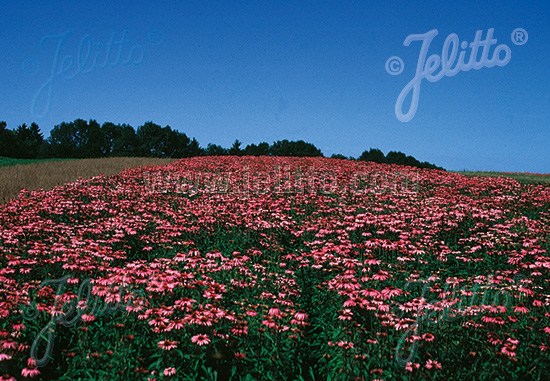
Echinacea purpurea 'Magnus' - this field is miles and miles away from another (potential) coneflowers, so cross pollinating happens withing these plants and the offspring will stay fairly uniform. Picture from Europe.
Copyright : Seed company Jelitto
The seed cultivars from the chart are :
- -'Ruby Star'=3rd best for pollinators (out of 75)
- -'Baby Swan Pink' = the 7th best for pollinators
- -'Magnus' = the 9th best for pollinators
- -'Pow Wow White' = the 13th best for pollinators
- -'White Swan' = the 16th best for pollinators
These above are not rated highly in performance, because they still keep the natural look, somewhat drooping petals, that airy/leggy appearance, which make them look poor or loose in comparison to bold, compact and tight clumps of new hybrids….But don’t worry, the seed cultivars, and the species of Echinacea purpurea are still pretty good garden plants, that gained enough points :
Echinacea pallida 3.7 points (out of 5)
Echinacea pallida ‘Hulla Dancer’ 3.7 points
Echinacea purpurea 3.6 points
Echinacea purpurea ‘Baby Swan Pink’ 3.5 points
Echinacea purpurea ‘Baby Swan White’ 4.2 points
Echinacea purpurea ‘Magnus’ 3.9 points
Echinacea purpurea ‘Ruby Star’ 4.1 points
Echinacea tennesseensis 3.5 points
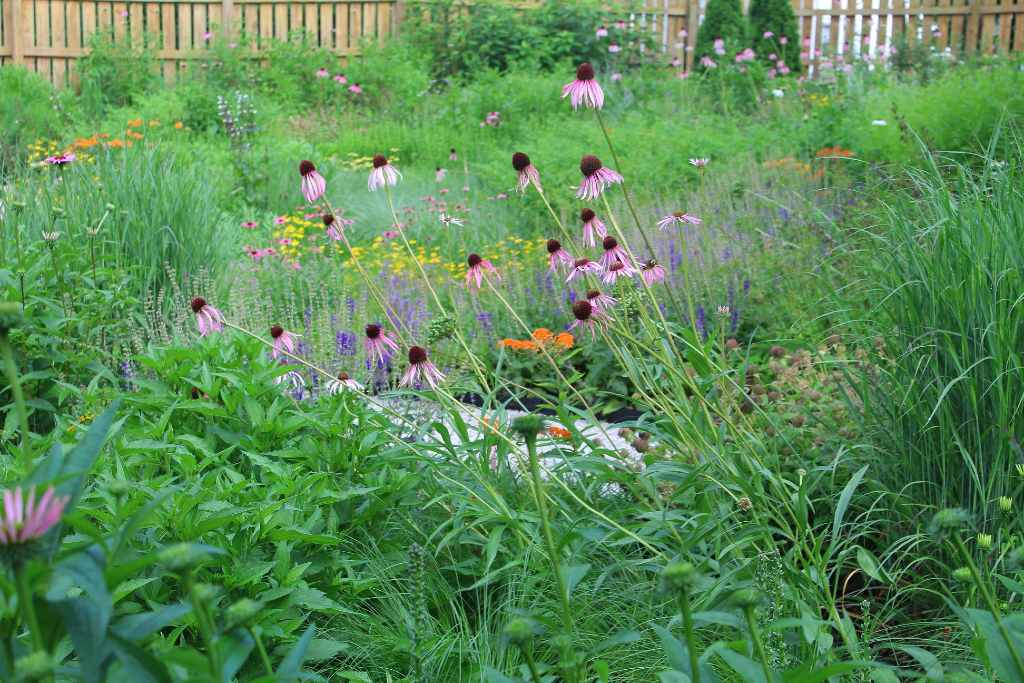
Echinacea pallida - leaning towards the sun in half-sun flower bed. Perfect in it's imperfection. Well balanced and well layered naturalistic landscape design with soil being covered by plants for the whole year. Notice that E. pallida is in full bloom or nearly slightly over, while Echinacea purpurea 'Ruby Star' (on the far let) is only budding and opened it's first flower. Most of the tall coneflower provide wonderful black seedheads that persist for the fall and winter. With courtesy of Andrew Marrs Garden Design, Bloomington, Indiana.
The trend to breed the dense-mounded, compact and lower plants is obvious with other perennials too.
Honestly, I don’t always like such a look, because the airy, dangling and somehow “imperfect” plants look very real and natural in gardens. Imagine English cottage garden full of perfectly mounded plants, that sits in the garden with their perfect shape, without intermingling with other plants….that’s Mission Impossible….
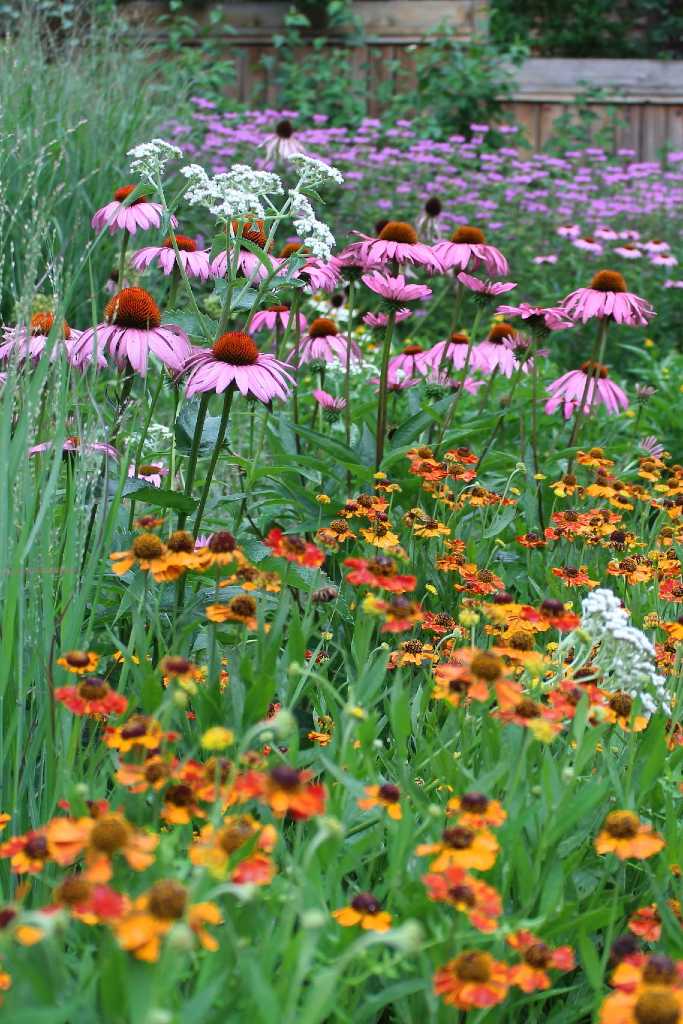
Above - Echinacea purpurea 'Ruby Star' has still very natural look and height. Andrew Marrs Garden Design, Bloomington, Indiana.
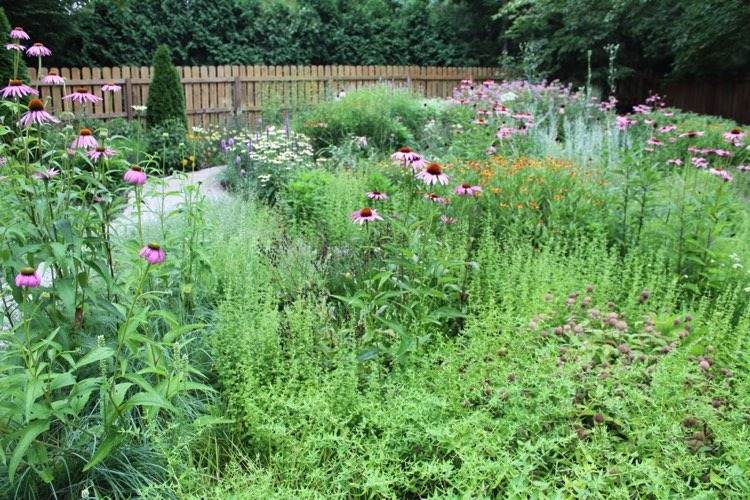
The same garden, but earlier, about 2 years after planting. Originally in this garden were planted both - Echinacea purpurea (wild species, supposedly local genotype from local Spence nursery) and Echinacea purpurea 'Ruby Star' (North Creek Nursery). The species (E. purpurea) has wider and more variable gene base than 'Ruby Star' (see picture of isolated field of 'Magnus'). So several plants of the species (left on the picture) reached 5' and started to flop later on, which meant more work with deadheading and cutting plants back to prevent flopping. But the biggest issue of the species was low tolerance to summer droughts - these wilted, looked unhealthy and bad, so after two years were pulled out and replaced with 'Ruby Star', which handles the heat and drought much better, didn't wilt and bloomed till early fall. The wild populations are lot more unpredictable in look and performance and don't have to work the best in urban conditions with changed soil profiles in the streets and around houses. Back to pollinators chart - Echinacea purpurea placed as second best, 'Ruby Star' third best - "little" difference in amounts of pollinator visits, but huge difference in performance in garden conditions. (note - this doesn't have to work everywhere, so consider each place individually). Andrew Marrs Garden Design, Bloomington, Indiana.
The greatest thing about these seed cultivars (also pure Echinacea purpurea species) is, that you can buy packet of seeds for 5 dollars and grow 20 or 50 (or more) plants for your garden.
While with the patented plant, you’ll spend 10 to 15 dollars on one single plant easily… and when you want to divide, renew and refresh your 5-7 years old declining clump of to refresh the growth, just remember that the plants are patented/licensed and you cannot divide/propagate them without permission from the license holder...
"Insects are the little things that run the world." Dr. Doug Tallamy
The circle begins with plants that convert the sun energy into food, that is eaten by the first small animals – insects, that further serve the role of food for bigger animals or birds etc.
As D. Tallamy says, 2/3 of all insects species are herbivores (eating plants), so they need to feed on (host) plants = on the native plants that they co-developed with.
To prevent, slow down or stop the massive extinction, we need lots of insects, for example, it takes between 6,000 to 9,000 caterpillars to make one clutch of chickadees….
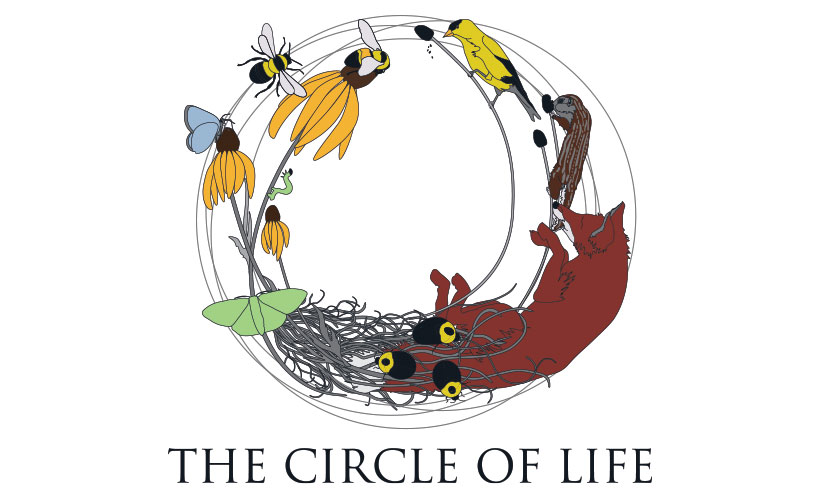
Above - Circle of life, Prairie Moon Nursery. If you're concern, that the insects will eat all of your plants coneflowers (or other native/nativar plants), the birds and other critters will protect them for you. Birds in your garden are big satisfaction and fun to watch.
What is interesting from Doug Tallamy’s studies : the herbivore insects don’t mind eating cultivars of native plants (nativars) at all. Unless we change the leaf color from green to red. Because the red-leaved, colorful-leaved cultivars contain lots of anthocyanins – protective color pigments, that makes the plant unpalatable for insects.
So far, I haven’t found answers for Doug Tallamy’s statement, that the clonal, vegetative propagated plants are trouble (since they don’t have diverse genetic base as generative propagated plants ).
I would see the trouble potentially in longer-lived woody species. But not with perennials.
My experience is, that if a perennial self-seeds, the seedlings always differ from original parent plants. And this works even for the patented multiple hybrids, with (some) tendencies to revert to the original forms. I’m sure, many gardeners experienced that it in their own gardens too.
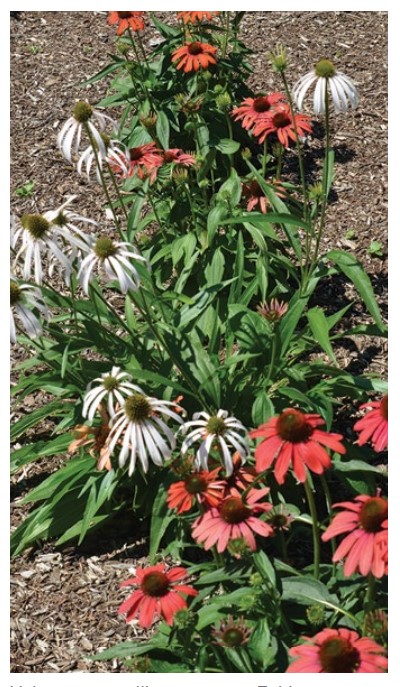
Volunteer seedling amongst Echinacea ‘Julia’ in the Trial Garden, Mt. Cuba Center, Echinacea trials 2020.
How I understand it, the clonal-vegetative nativars are not such a problem, because their genes are just sleeping potential of many possible of mutations and changes. Genes are simply not stable, they constantly change, transform and mutate. There is nothing to stop this natural process and this works for pure wildflowers and for nativars too. The exception are completely sterile cultivars, which some double or full-flowering cultivars can be.
Listen to great talk with Doug Tallamy on Native Plant Podcast.
What to do now?
Think, verify information and study yourself, don’t believe in the simplest solutions and black and white explanations. Manmade input and breeding can be useful, and in some cases can enhance attractiveness for pollinators.
Each cultivar has to be evaluated individually, because some are excellent, some are good and some are not that great.
Plants are not decoration and serve multiple functions. The more functions they provide, the better. When you have the knowledge or data, choose the cultivars that also feed pollinators and butterflies.
If you want pollinators and butterflies, avoid or limit cultivars with double or full flowers (this works not only for Echinacea, but for any perennials).
Use cultivars in garden, in urban areas, public spaces or city parks and don’t be afraid to use both – wildflowers and cultivars together. But go for wildflowers in countryside, restoration and naturalization in the more natural part of your property (find local Native Plant Society or local genotypes).
Don't blame cultivars and their garden use. The insect and bird decline is primarily caused by our exploitation and use of agricultural land (Photo copyright : Local Futures)
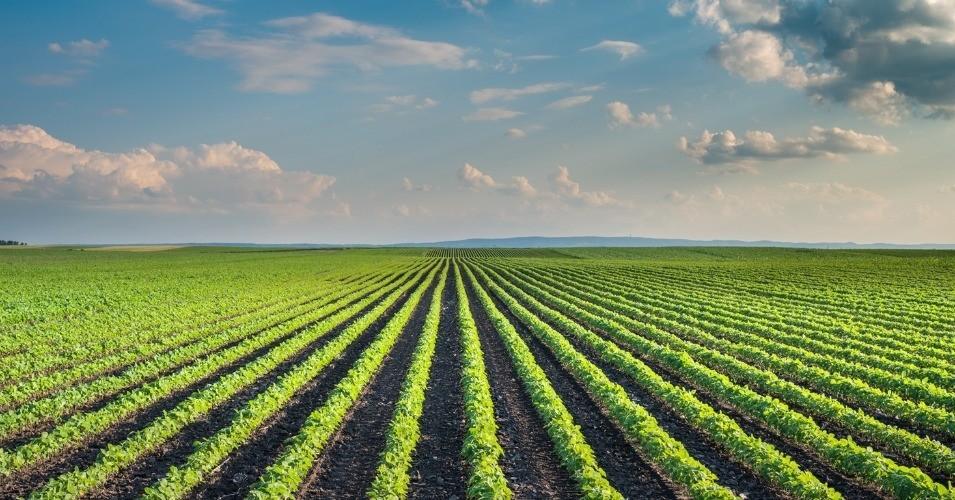
Grow flowers, not lawns. The higher diversity of species, the better and honestly any flower, no matter if annual, perennial, less or more hybridized is prettier and has higher ecological value than the lawn.
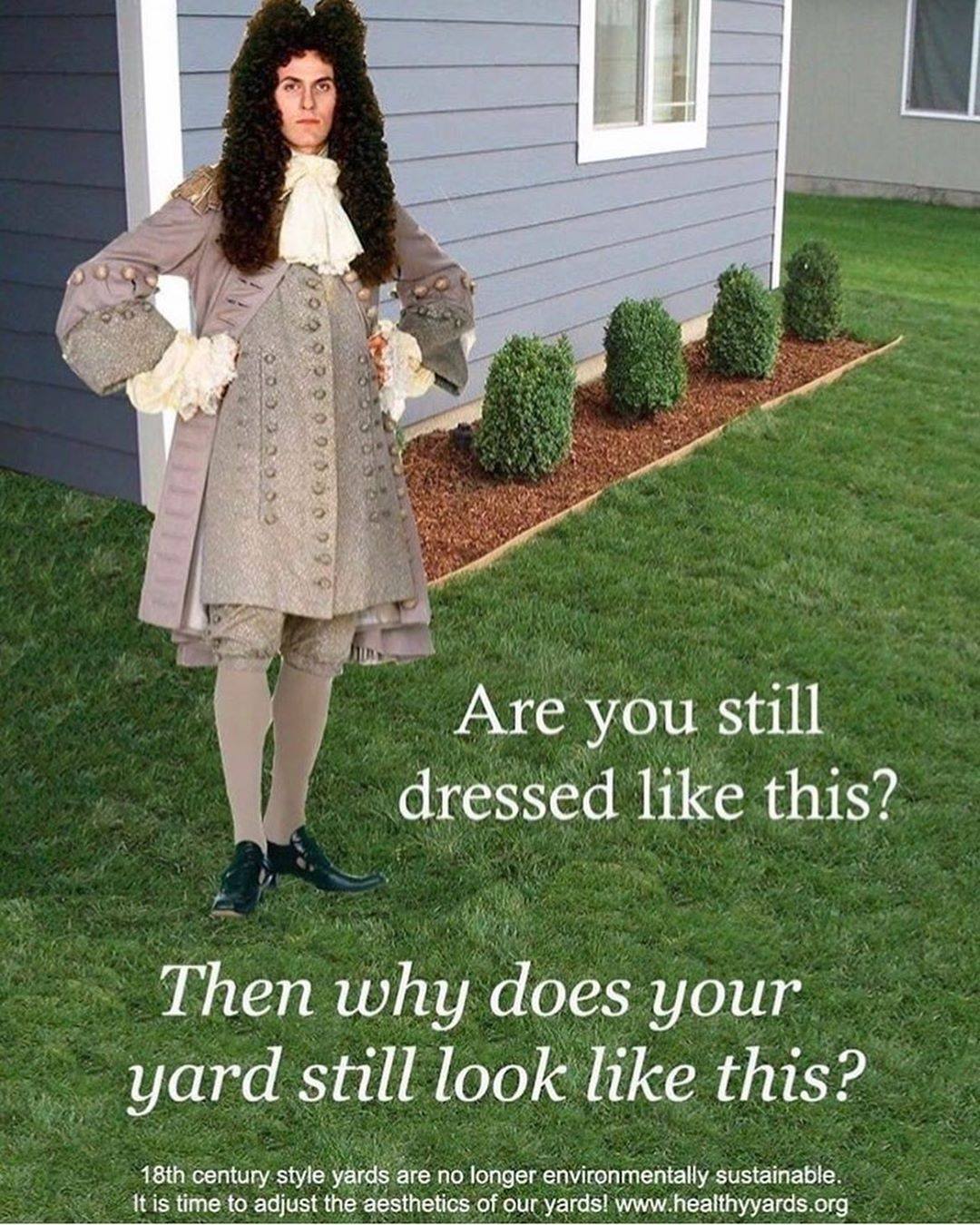

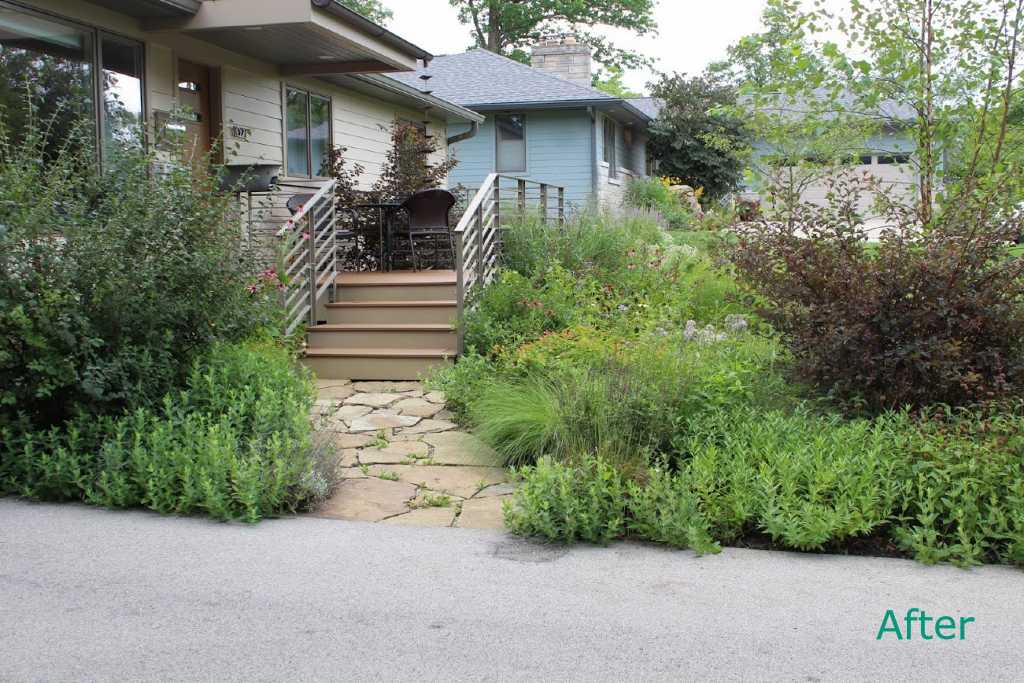
Before/after picture - Bloomington, Indiana, Andrew Marrs Garden Design

